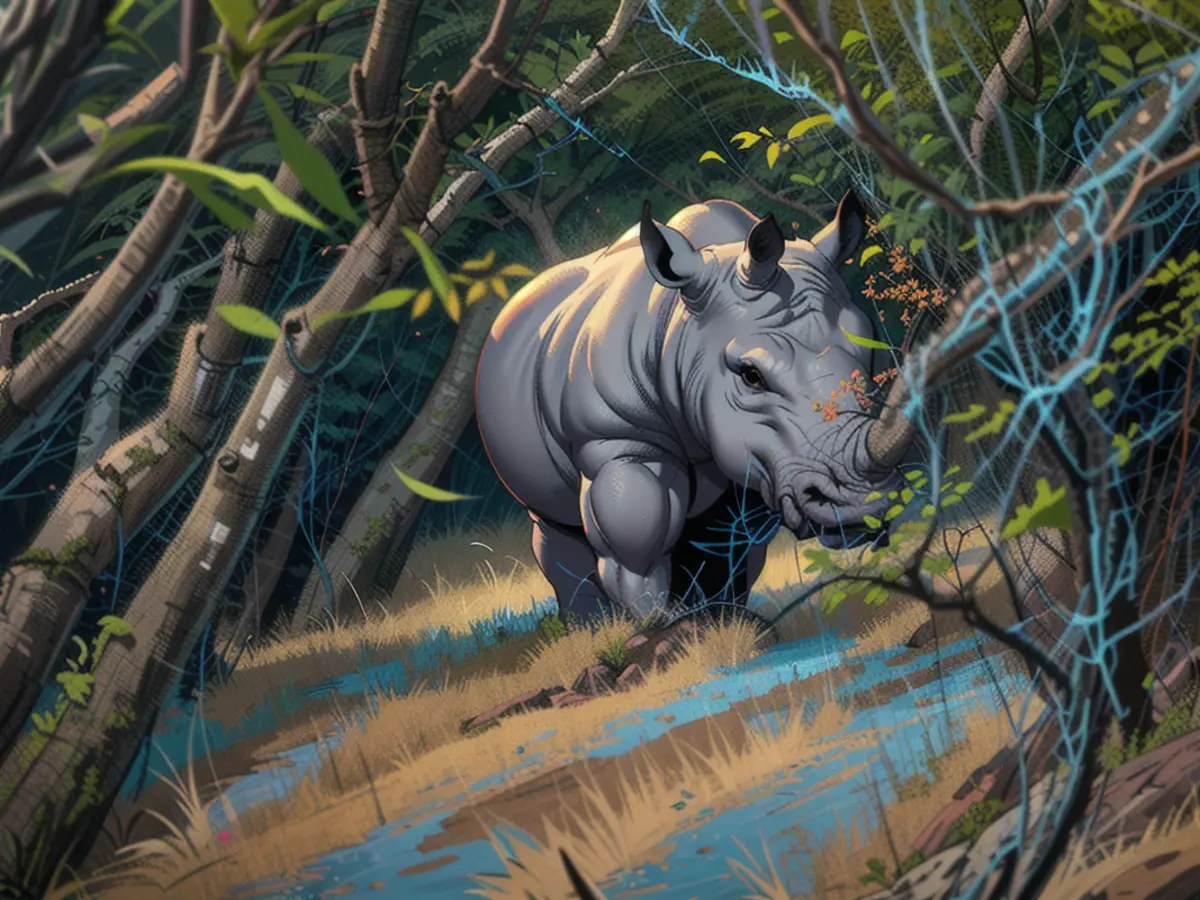"High-Tech Tracking: Keeping Tabs on Rhinos through 'Find My Friends' Application"
Previously widespread in Northern Kenya, the rhino population faced a severe decline by the early 1990s due to poaching. However, Kenya's black rhino population has increased by more than double since 1989, with a total of 1,900 black and white rhinos recorded by the end of December 2022, according to Kenya Wildlife Services.
Sera Conservancy has spearheaded community-led rhino conservation efforts in the country. In 2015, it created East Africa's first community rhino sanctuary with the introduction of 10 critically endangered black rhinos. The number has since grown to 21 black rhinos, which roam freely across 107 square kilometers (41 square miles) of designated sanctuary land. In February 2024, these rhinos received company from four white rhinos from the neighboring Lewa Conservancy.
As Dr. Ruoro-Oundo hunts on foot, she locates two female white rhinos. One, known as Sarah, appears heavily pregnant. However, upon approaching, she notices something is amiss. Dr. Ruoro-Oundo decides not to intrude too much into the rhinos' territory and chooses to utilize a conservation technology tool known as EarthRanger. By monitoring Sarah's movements in real-time from afar, she can track her location and activity.
Each of the four white rhinos has been fitted with a GPS tag in their horns and ears, which communicates their location to remote devices or the Conservancy's operations center. These tags allows Dr. Ruoro-Oundo to observe Sarah and detect that her condition is rapidly deteriorating.
Suffering from constipation, Sarah's vaginal and rectal areas are bloated, causing her immense pain and discomfort. Fearing for both her and her unborn calf's life, a prompt intervention is carried out by Kenya Wildlife Services and Sera Conservancy personnel. Upon further examination, it's discovered that Sarah requires medical assistance to alleviate her distress.
For Dr. Ruoro-Oundo, the future of wildlife conservation lies in the combination of human intervention and technological advancements.
"Technology cannot be separated from conservation in the future," she emphasizes. "The human element will always be essential, but technology is there to support us in our efforts."

EarthRanger, which is currently used in 70 countries, first came into existence in Kenya during Wall's elephant research study. Its origins can be traced back to 2012 when poaching was a prevalent issue in Kenya, and they needed a way to immediately identify and track down elephants that fell victim to poachers. He developed an algorithm that could predict whether an elephant's movement had ceased for at least five hours, which would trigger an SMS alert.
Over time, EarthRanger has evolved into a more comprehensive platform. Today, it tracks 9,000 animals in Kenya, including elephants, lions, giraffes, tortoises, sea turtles, and 1,200 rhinos. It can integrate information from over 100 different devices, such as rhino ear tags, lion collars, giraffe tail tags, and turtle shell attachments. Additionally, it accesses data from vehicle trackers, satellite information, and remote sensing alerts for deforestation and fire. All this information is brought together on a single platform, allowing for quick visualization, analysis, and intervention.
All the devices are designed to be lightweight, durable, and non-intrusive for the animals, causing no disturbance to their natural behaviors or causing discomfort. Dr. Ruoro-Oundo notes that the process of attaching a tracker for a rhino is similar to a human having their ears pierced.
Samuel Lekimaroro, working as a wildlife protection manager for Northern Rangelands Trust and responsible for Sera Conservancy, utilizes this type of data to monitor both land and sea animals across a vast area of 6.5 million hectares. Notably, it has proven to be a valuable aid in various endeavors ranging from translocating wildlife to data collection and implementation of security measures.
Lekimaroro expresses his gratitude, claiming that the usage of EarthRanger has led to a significant reduction in elephant poaching in their conservancies. The number of elephants killed in these areas has decreased from 120 in 2012 to zero over the past four years.
The innovative aspect of EarthRanger extends beyond this, according to Wall. It offers the capability to collect and share data securely from multiple EarthRanger locations around the globe. By storing such information, it becomes possible to retrieve data from different sites and combine it for a more in-depth analysis than ever before. This feature has allowed organizations to engage in joint patrols and wildlife monitoring, resulting in shared information.
Read also:
- This will change in December
- Dikes withstand water masses so far - Scholz holds out the prospect of help
- Fireworks and parties ring in 2024 - turn of the year overshadowed by conflicts
- Attacks on ships in the Red Sea: shipping companies avoid important trade route
The successful conservation efforts in Kenya have contributed to the growth of the rhino population not just in Kenya, but also across the world.
The increasing use of technology in wildlife conservation has sparked global interest, with tools like EarthRanger being implemented in 70 countries worldwide.
Source: edition.cnn.com







